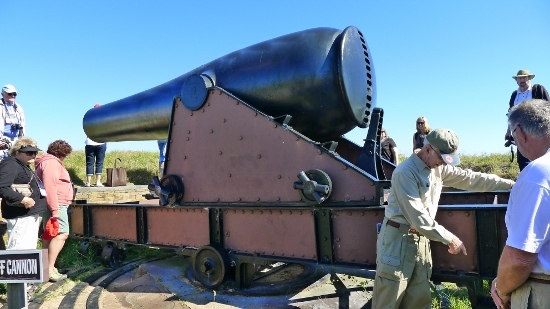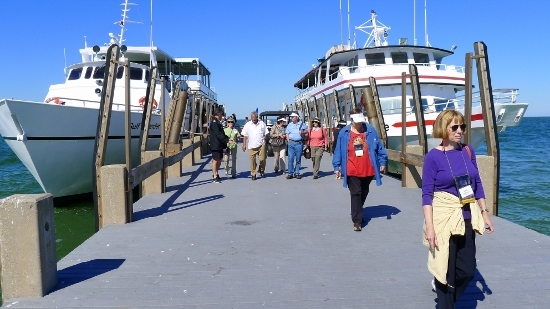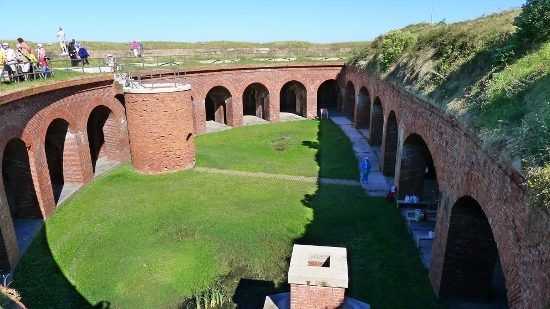You'll need to bring more than your swimsuit and tanning oil to the white sands of Ship Island off the Mississippi coast's resort area. Also bring a good imagination, because a lot of history was made on this little island, one of a chain of specks separating the Gulf of Mexico from the Mississippi Sound.
It's about an hour-long boat ride across the Sound from the dock at Gulfport to the stringbean-shaped island. Half-way out, three miles of beaches running along its northern shore start popping up on the horizon, and you can make out a sort of bump on one side of its mostly flat and barren terrain.
Huge Rodman cannon atop the fort fired 400-pound balls.
You dock near the bump, and it turns out to be a Civil War-vintage fort the height of a three-story building topped by an enormous cannon. Sun-lovers head off on a half-mile-long walkway to the far side of the island, where the best beaches are. Others stick around the landing area for a tour of the fort, which covers about a third of a modern-day city block and looks much like a horseshoe with the open side filled in.
This would be a good time to activate your imagination, because the guide - an employee of the U.S. National Park Service - paints vivid word-pictures of all the history book-fillers that went on here over the centuries.
First, he tells you, the island got its name in 1699 when French explorers found it had a deep-water, ship-friendly anchorage. Hence the tag, Ship Island.
That deep-water feature of the island was a big deal, because the waters around other islands edging the 100-mile Sound from Mobile Bay to New Orleans were too shallow to anchor big ships (much less fleets of them).
Visitors come ashore on the island.
So guess where the British navy decided to set up a staging area when they were getting ready to attack New Orleans in the War of 1812. That's right, at Ship Island. Try to imagine 60 warships bobbing around at anchor while 10,000 troopers ran around the island practicing maneuvers for the coming battle.
They lost, and the British fleet came limping back to the island to rest up for the trip back home.
After that, the guide tells you, the U.S. government decided to dot the so-called "barrier" islands from Florida to Texas with a string of forts. The one on Ship Island was among the most important, but it was one of the last projects to clear all the red tape. So it was only partially built when Mississippi seceded from the Union in January 1861.
Some of the fort's 37 gun ports.
The break-away prompted the Mississippi militia to boot the construction workers off Ship Island -- three months before Confederate gunners blasted the Union stronghold of Fort Sumter to officially launch the Civil War.
The Confederate stars and bars were flying over the fort on Ship Island when the Union steam-powered gunboat U.S.S. Massachusetts showed up in July to lob some shells at the rebels, who then lobbed some shells back at the gunboat. The lobbing lasted about 20 minutes, during which little damage was done and no one was seriously hurt. Both sides claimed victory.
Although it wasn't much of a fight, the skirmish scored two entries in the chronicles of the Gulf Coast. First, it was the only time the fort saw action. And it led to the naming of the until-then unnamed project: Fort Massachusetts (after the Union steamer that attacked it).
Tour takes visitors to the fort's underground chambers.
The rebels opted to abandon the island that fall, after which it was re-occupied by Union forces. They went back to work on the fort, but by the time it was finished in 1866 the four-year war was over.
You'll need to stir your imagination again to conjure up views of the fort and the island over the war years. Like the Brits, Admiral David Farragut used Ship Island as a staging area for a fleet of warships before he headed off to damn the torpedoes (they were actually mines) to capture Mobile Bay in 1862. At various times during the war the island was home to as many as 27 Union regiments and 3,000 rebel prisoners.
Fast-forward to today, and there's not much on the island besides the dock, Fort Massachusetts, some nearby buildings bearing the logo of the National Park Service, a few walkways and a snack bar on one of the beaches. Still, thanks to the tour guides, it's not hard to picture the island when it was much like a small city with thousands of soldiers and sailors unloading lines of supply ships, cleaning out stables, gambling away their meager pay, cooking meals, writing letters to the folks back home, digging wells in the sand, cleaning their rifles, sharpening their bayonets and elsewise getting ready to do things on the mainland that ended up in our history books.
Fort armaments: Fort Massachusetts was designed to bristle with as many as 37 cannons, but some were never mounted. The biggest ones were two 15-inch Rodmans that could fire 400-pound balls three miles. Also atop the fort were two 100-pounder Parrott Rifles (cannons with rifled barrels that fired large bullet-shaped projectiles with deadly accuracy).
All photos by Bob Schulman.



